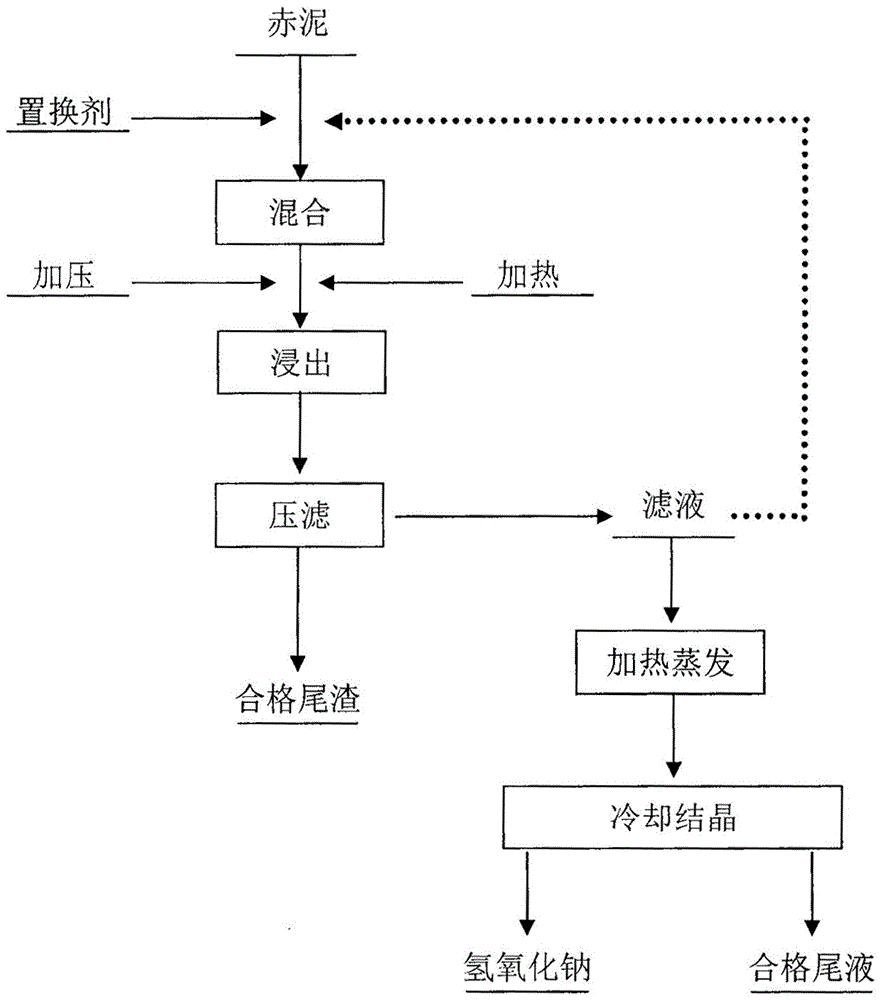Sodium hydroxide recovery method of red mud
A technology of sodium hydroxide and red mud, applied in the direction of alkali metal hydroxide, chemical instruments and methods, solid waste removal, etc., can solve the problems of low activity of red mud, long operation time, low sodium removal rate, etc., and achieve The effect of low leaching stages, short operation time and high sodium removal rate
- Summary
- Abstract
- Description
- Claims
- Application Information
AI Technical Summary
Problems solved by technology
Method used
Image
Examples
Embodiment 1
[0019] Mix red mud with 5-10% replacement agent, and then carry out stirring and leaching in a pressurized heating and stirring device. The leaching temperature is 120-160°C, the leaching pressure is 0.5-1Mpa, and the mass ratio of leaching liquid to solid is 2-5. : 1. The leaching time is 15~25min. After the stirring and leaching is completed, the qualified tailings and filtrate are obtained through pressure filtration, and the filtrate is returned as a leaching solvent for recycling to leaching new red mud. The number of cycles is 10~12 times, and then the recycled The filtrate is heated and evaporated at a temperature of 140-150°C for 60-80 minutes, and then rapidly cooled to crystallize sodium hydroxide. The recovery rate of sodium hydroxide is greater than 97%, the purity of sodium hydroxide is greater than 99%, and the tail liquid after crystallization is qualified tail fluid.
[0020] The content of sodium oxide in the qualified tailings obtained in this example is less...
Embodiment 2
[0022] Mix the red mud with 10-15% of the replacement agent, and then carry out stirring and leaching in a pressurized heating and stirring device. The leaching temperature is 160-200°C, the leaching pressure is 1-1.5Mpa, and the mass ratio of the leaching liquid to solid is 2~ 5:1, the leaching time is 25~35min. After the stirring and leaching is completed, the qualified tailings and filtrate are obtained through pressure filtration, and the filtrate is returned as a leaching solvent for recycling to leaching new red mud. The number of cycles is 10~12 times, and then the recycled The filtrate is heated and evaporated at a temperature of 120-140°C for 80-100 minutes, and then rapidly cooled to crystallize sodium hydroxide. The recovery rate of sodium hydroxide is greater than 97.5%, the purity of sodium hydroxide is greater than 99.2%, and the tail liquid after crystallization is Qualified tail liquid.
[0023] The content of sodium oxide in the qualified tailings obtained in ...
Embodiment 3
[0025] Mix the red mud with 15-20% of the replacement agent, and then carry out stirring and leaching in a pressurized heating and stirring device. The leaching temperature is 200-240°C, the leaching pressure is 1.5-2Mpa, and the mass ratio of leaching liquid to solid is 2-5. : 1. The leaching time is 35~45min. After stirring and leaching, press filter to obtain qualified tailings and filtrate. The filtrate is returned as a leaching solvent for recycling to leaching new red mud. The number of cycles is 10~12 times, and then the recycled The filtrate is heated and evaporated at a temperature of 100-120°C for 100-120 minutes, and then rapidly cooled to crystallize sodium hydroxide. The recovery rate of sodium hydroxide is greater than 97.9%, the purity of sodium hydroxide is greater than 99.4%, and the tail liquid after crystallization is qualified tail fluid.
[0026] The content of sodium oxide in the qualified tailings obtained in this example is less than 0.3%, and the conte...
PUM
 Login to View More
Login to View More Abstract
Description
Claims
Application Information
 Login to View More
Login to View More - R&D
- Intellectual Property
- Life Sciences
- Materials
- Tech Scout
- Unparalleled Data Quality
- Higher Quality Content
- 60% Fewer Hallucinations
Browse by: Latest US Patents, China's latest patents, Technical Efficacy Thesaurus, Application Domain, Technology Topic, Popular Technical Reports.
© 2025 PatSnap. All rights reserved.Legal|Privacy policy|Modern Slavery Act Transparency Statement|Sitemap|About US| Contact US: help@patsnap.com

